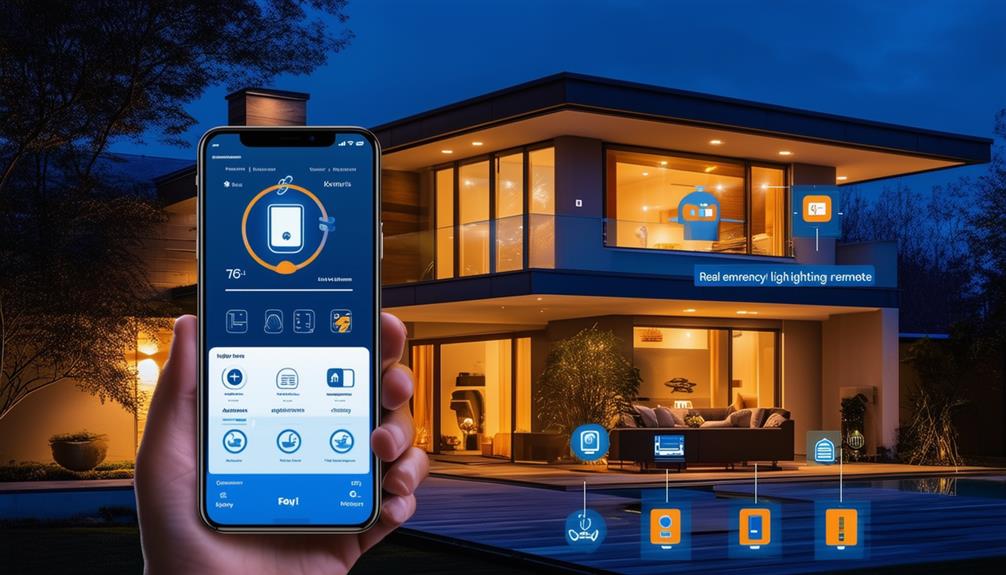Integrating Smart Home Technology With Emergency Lighting

Imagine enhancing your home's safety with smart technology that not only illuminates your path during emergencies but also adapts to real-time situations. Integrating smart home systems with emergency lighting ensures rapid, targeted responses, providing optimal visibility when you need it most.
This integration allows for remote monitoring and automated maintenance, ensuring compliance with safety regulations. You might wonder how these advancements can seamlessly fit into your existing setup and what future trends could further revolutionize emergency lighting. So, how exactly do these smart systems work, and what are the key benefits you should consider?
Importance of Emergency Lighting

Emergency lighting is crucial for ensuring safe evacuation during power outages or emergencies in buildings. Without it, navigating dark corridors and exits can become perilous, endangering lives. Compliance with standards such as BS EN 50172 isn't optional; it's mandatory to ensure these systems function when needed most.
Smart emergency lighting systems represent a significant advancement in Life Safety. They offer self-testing capabilities that minimize the need for manual inspections, ensuring that lights are always operational. These smart systems can alert users to failures or maintenance requirements in real-time, thereby enhancing overall reliability.
Additionally, integrating external sensors into these systems can be transformative. These sensors can detect the presence of individuals and guide them toward safe exits, thereby improving evacuation efficiency. This feature is particularly beneficial for first responders, as it helps locate individuals quickly during emergencies.
Incorporating smart technology into emergency lighting not only enhances safety but also offers financial benefits. Improved Life Safety measures can potentially lower insurance premiums, providing both peace of mind and financial savings. Therefore, investing in smart emergency lighting isn't merely about compliance—it's about ensuring comprehensive safety and efficiency.
Role of IoT in Emergency Systems
By leveraging IoT technology, emergency systems can achieve unparalleled levels of reliability and efficiency. Imagine an emergency lighting control system that's both connected and smart, allowing for remote monitoring and management to ensure optimal functionality during a crisis. Connected emergency lighting systems provide real-time updates, keeping you informed about their status at all times.
In a smart building, IoT enhances safety by integrating emergency lighting with advanced sensors and digital drivers. These sensors can detect smoke, fire, or even trapped individuals, providing crucial information to first responders. This isn't just about illumination; it's about intelligent illumination that reacts to the situation. You get more than emergency lights; you get a proactive system designed to save lives.
IoT-enabled self-testing features eliminate the need for manual checks of each light fixture, ensuring everything is up to code and functioning optimally. This network connectivity transforms emergency lighting from a passive system to an active guardian of safety. With IoT, your emergency systems aren't just compliant; they're smart, connected, and always ready.
Benefits of Smart Emergency Lighting

Smart emergency lighting systems offer a transformative approach to building safety and regulatory compliance. A key advantage is the provision of real-time monitoring, allowing you to instantly check the status of each emergency light. This eliminates the risk of unnoticed failures and significantly enhances safety measures.
Additionally, these systems remove the need for manual monthly inspections, saving both time and resources. Maintenance schedules can be automated, and push notifications ensure timely interventions, keeping lights in optimal condition.
Cloud-based systems further enhance convenience by enabling remote monitoring. This ensures compliance with standards such as UL 924, which requires lights to operate at full brightness for 90 minutes during emergencies.
Integrating Sensors for Safety
Integrating sensors into your emergency lighting system enhances fire detection and enables real-time monitoring. These smart sensors can adjust lighting based on current conditions, ensuring a safer environment.
Enhanced Fire Detection
Integrating intelligent sensors into your emergency lighting system significantly enhances fire detection capabilities. These smart systems can detect smoke, heat, or flames, ensuring robust fire safety measures.
Here's how intelligent sensors elevate fire detection:
- Early Detection: These sensors identify smoke, heat, or flames more quickly than traditional systems. This rapid detection triggers your emergency lighting immediately, providing clear evacuation pathways.
- Improved Response Times: Detecting fires at their earliest stages allows for faster activation of emergency lighting and other safety protocols. This quick response gives you more time to evacuate or take action.
- Enhanced Safety: Intelligent sensors ensure that emergency lights are activated precisely where and when needed. This targeted response boosts overall safety and helps prevent panic during emergencies.
- Seamless Integration: Smart technology enables the easy incorporation of these sensors into your existing emergency lighting system, enhancing both fire safety and the efficiency of your emergency response.
Real-Time Monitoring
How can integrating sensors into your emergency lighting system provide real-time monitoring to significantly enhance safety? By incorporating sensors that detect motion, smoke, or fire, your emergency lighting systems can activate immediately during critical situations. These intelligent sensors continuously monitor occupancy levels and environmental conditions, ensuring that your response is both prompt and appropriate.
Real-time monitoring transforms your emergency lighting system into a proactive safety measure. The sensors deliver continuous data, enabling the system to adapt to changing conditions instantly. This capability is crucial during emergencies, where every second matters. If smoke or fire is detected, the sensors can trigger the emergency lights, guiding occupants to safety without delay.
Furthermore, integrating sensors ensures that your emergency lighting system isn't only reactive but also preventative. By monitoring occupancy, the system can identify high-risk areas and ensure they're well-lit, reducing the likelihood of accidents. This real-time insight enhances overall safety and guarantees swift response times.
Adaptive Lighting Solutions
Smart sensors transform emergency lighting systems into adaptive solutions that adjust to environmental conditions, ensuring maximum safety. By integrating smart sensors into your emergency lighting setup, you can significantly enhance your building's safety measures. These sensors detect movement, smoke, or fire, triggering the emergency lights to illuminate and guide occupants to safety. This adaptive lighting solution guarantees that light levels automatically adjust to maintain visibility during emergencies.
Here are four key benefits of integrating smart sensors for adaptive lighting solutions:
- Enhanced Safety: Smart sensors enable emergency lights to react proactively to hazards such as smoke or fire, significantly improving overall building safety.
- Optimal Visibility: By automatically adjusting light levels, these systems ensure optimal visibility, helping occupants locate exits quickly and safely.
- Energy Efficiency: Smart sensors activate lights only when necessary during emergencies, reducing energy waste and improving overall energy efficiency.
- Immediate Response: The system's ability to detect movement and environmental changes ensures an immediate response, offering a proactive approach to safety.
Remote Monitoring Capabilities

Remote monitoring capabilities offer real-time status updates for every emergency light in your system. By integrating these smart systems with cloud-based technology, you can supervise emergency lighting across multiple buildings from a centralized location. This advanced setup eliminates the need for manual monthly checks, providing automated maintenance schedules and push notifications to keep you informed.
Remote monitoring boosts efficiency and ensures compliance with safety regulations. You gain quick access to test reports and maintenance data, allowing you to address issues promptly. This proactive approach keeps you aware of your system's health, reducing the risk of non-compliance and enhancing overall safety within your properties.
Additionally, the ability to monitor emergency lights remotely enables immediate response to problems, minimizing downtime and ensuring operational lighting when needed. This integration of smart systems into your emergency lighting setup ensures that every light functions correctly without constant manual oversight. Leveraging remote monitoring enhances the safety and efficiency of your emergency lighting system.
Setting Up Smart Systems
Setting up smart emergency lighting systems is straightforward and significantly improves safety and convenience. Using smartphone apps, you can manage your emergency lighting system from anywhere. These systems are designed to provide 100% brightness for 90 minutes during power outages, ensuring visibility and safety.
To set up your smart emergency lighting system, follow these steps:
- Install Controllers: Utilize controllers like the Radiar AR10, which include UL924 listed options, to streamline the management of your emergency lighting system.
- Download the App: Leverage mobile and web applications such as Lumos Controls to configure your lighting modes remotely. These apps enable you to manage your lighting system directly from your phone.
- Select the Zone: Within the app, choose the specific zone where you want to deploy the emergency lighting.
- Configure Settings: Access the device settings and activate the Emergency Mode option. This ensures that during a power outage, the system automatically switches to emergency mode, overriding all other controls.
Compliance and Testing Automation

Ensuring your intelligent emergency lighting system meets compliance standards requires regular testing and automation to streamline the process. Compliance with BS EN 50172 / BS 5266-8 standards mandates monthly and annual testing.
Monthly tests typically last ten minutes, while annual tests require three hours of operation to confirm functionality. Manual testing can be time-consuming and challenging, particularly for large systems. An emergency lighting test system like LuxIntelligent offers a streamlined solution.
Building managers benefit significantly from automated testing systems. By integrating LuxIntelligent, you can establish automated maintenance schedules to ensure tests are conducted without manual intervention. This not only saves time but also reduces costs associated with manual testing.
Additionally, the system promptly records test results, simplifying the identification and resolution of any issues, thereby ensuring ongoing compliance.
Automating your emergency lighting test system simplifies the compliance process, allowing building managers to focus on other critical tasks. Automated systems ensure that your emergency lighting remains functional and compliant with standards, eliminating the hassle of manual checks. Utilizing technology, you can maintain a safer environment efficiently and cost-effectively.
Future Trends in Emergency Lighting
Embracing automation for compliance opens the door to investigate future trends in emergency lighting, driven by IoT and smart technology integration. The landscape of modern emergency lighting is evolving rapidly, thanks to advancements in building management systems and smart emergency solutions. These innovations not only improve safety but also streamline maintenance and monitoring.
Here are four key trends shaping the future of emergency lighting:
IoT Connectivity:
Smart emergency lighting systems are becoming increasingly interconnected through IoT technology, enabling remote monitoring, self-testing, and real-time updates. This connectivity ensures that emergency lighting remains operational and compliant at all times.
Sensor Integration:
Modern emergency lighting systems are incorporating external sensors to assist responders in locating individuals during emergencies. This critical feature can significantly enhance emergency response times and outcomes.
Insurance Benefits:
The life-saving potential of advanced emergency lighting systems is recognized by insurers, leading to potential reductions in insurance premiums for building owners due to the added safety these systems provide.
Advanced Technologies:
The future of emergency lighting is promising, with ongoing advancements in smart sensors and digital drivers. These technologies will continue to evolve, offering improved functionality and reliability.
Conclusion
Integrating smart home technology with emergency lighting enhances both safety and efficiency in your home. Utilizing sensors and IoT, you benefit from early fire detection, real-time monitoring, and targeted light activation.
Remote monitoring ensures compliance with safety regulations and enables swift issue resolution. Embrace smart systems for adaptive, energy-efficient lighting solutions that provide peace of mind and a safer living environment. The future of emergency lighting is here, and it's more intelligent than ever.




